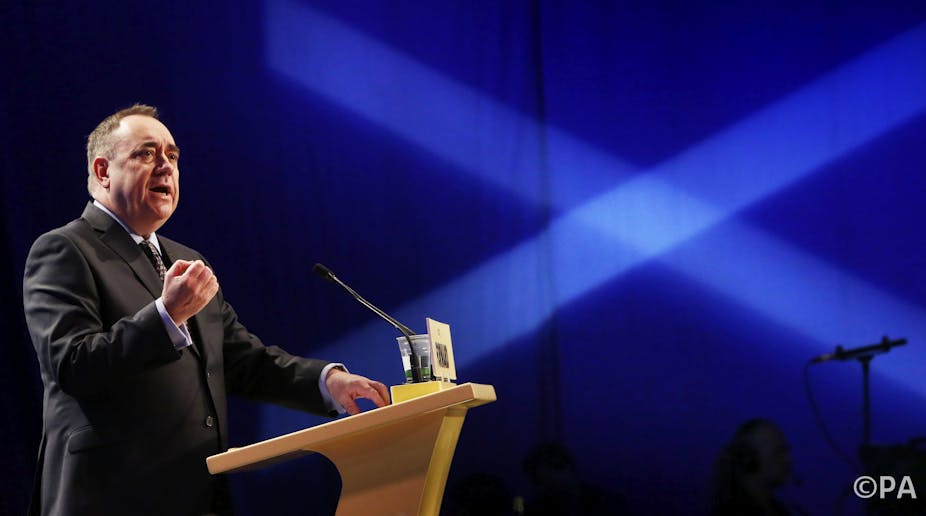Of all the party conference speeches SNP leader Alex Salmond has made over the years, Saturday’s in Aberdeen was probably the biggest. As the last conference speech before referendum day on 18 September, his independence pitch had a national and international audience.
In many ways it was a classic Salmond speech. It was directed at activists in the hall as well as the electorate as a whole – or rather two specific and large sections of that electorate: women and Labour voters.
The pitch to Labour voters has been a theme of Salmond speeches for many years. He has been making appeals to them ever since he came into politics in West Lothian in the late 1970s. These appeals have been sufficiently successful that in the 2007 and 2011 Scottish elections, the SNP replaced Labour as the dominant force in Scottish politics. In 2011 this helped it attract a larger share of the working class vote for the first time.
The party has built its success on occupying a range of formerly popular Labour policies such as free university tuition, free NHS prescription charges and maintaining a public sector health service.
Vote yes, choose Labour!
This time Salmond wasn’t asking Labour voters to switch to the SNP, but to vote yes in September in the knowledge that they can return safely to voting Labour afterwards – and a more popular non-Westminster version of Labour at that.
He referred to a “Labour Party leadership that has totally lost its way, that has lost touch with the values of Labour voters”.
“Independence will be good for Scottish Labour,” he said. “The Labour Party, freed from Westminster control, will have the chance to return to its core values: many of which we in this party agree with and share.”
Just like in 1979 and 1997, an alliance of Labour and SNP voters will be sufficient to see the yes campaigners over the line to victory. The thing to understand about the current referendum is that it’s actually quite ideological. The debate reflects centre-left politics, policies and values, which tells you quite a lot about Scottish politics.
The yes camp’s ideological approach dates back to the campaign launch in May 2012, when it featured a range of Labour supporters explaining why they would vote for independence. It has continued this type of approach ever since, with Salmond emphasising in his speech on Saturday everything from Scottish Water remaining in public ownership to a pledge to rid Scotland of nuclear weapons post-independence to the NHS being “softened up” by UK government for privatisation.
Divide and rule
Contrast this with the ideological incoherence of the no campaign – Better Together – which has Labour sitting next to the pro-austerity Conservatives. This is sufficiently uncomfortable that Labour set up its own campaign group in a bid to keep its large pool of voters in the no camp.
Trying to exploit that divide, Salmond told the party faithful, “The era of Tory governments unelected by the people of Scotland, handing out punishment to the poor and the disabled will be gone and gone for good.”
Regarding Salmond’s appeal to women in Saturday’s speech, another common strand in recent years, the polls have shown men are much more likely to support yes in the referendum. This gender gap used to exist in SNP voting intentions but was closed at the 2011 Scottish election in spectacular fashion. Alongside the SNP’s triumph with working class voters, the party also took the biggest share of women.
Salmond’s appeal to women in his conference speech involved both policy and personnel. He elevated two female ministers, Angela Constance (youth employment) and Shona Robison (equality) to the Scottish cabinet in a move to ensure that at least 40% of the posts are held by women - reflecting the Scottish government’s intention to achieve the same sort of balance in boardrooms.
“The cabinet is our board as a country, and women will make up 40% if the members of the Scottish cabinet,” he said.
Up with the kids
There have also been several policy initiatives on childcare from the Scottish government during the SNP administration and in plans post-independence that were announced back at the launch of the government’s White Paper in November 2013.
“In an independent Scotland, we will build a system of childcare that will be the envy of the world,” Salmond told the conference. “High quality universal childcare and early learning - for all of Scotland’s children. That’s the independence pledge.”
In some senses, the SNP is going a bit Nordic here. In keeping with fellow travellers on the yes side such as the Greens and the Scottish Socialists, the SNP has been looking to its Scandinavian neighbours for policy goals and ideas in pursuit of a fairer society. Again, the contrast with London could not be more pronounced.
In short, there was nothing hugely surprising in this Salmond speech. The first minister used his usual powerful oratory to hammer home the same strategic priorities that have been the SNP’s focus for some time. It was never about producing a game-changing moment but continuing to build the momentum that will energise the grass roots into taking the argument these next few months to community halls, local gatherings and doorsteps around the country.

It was also about helping to provide focus for the European elections next month. A decent showing for the SNP will be very important in increasing the sense that success in September will come. But SNP strategists will be looking closely at UKIP’s showing in England. The stronger they perform, the more the SNP’s narrative about the differences between Scotland and England will be underlined.

